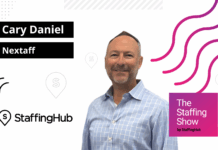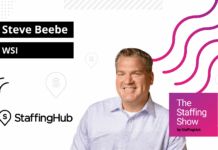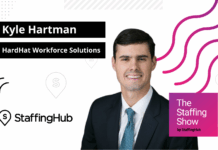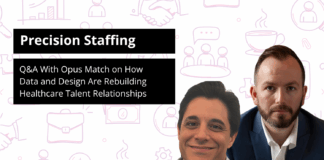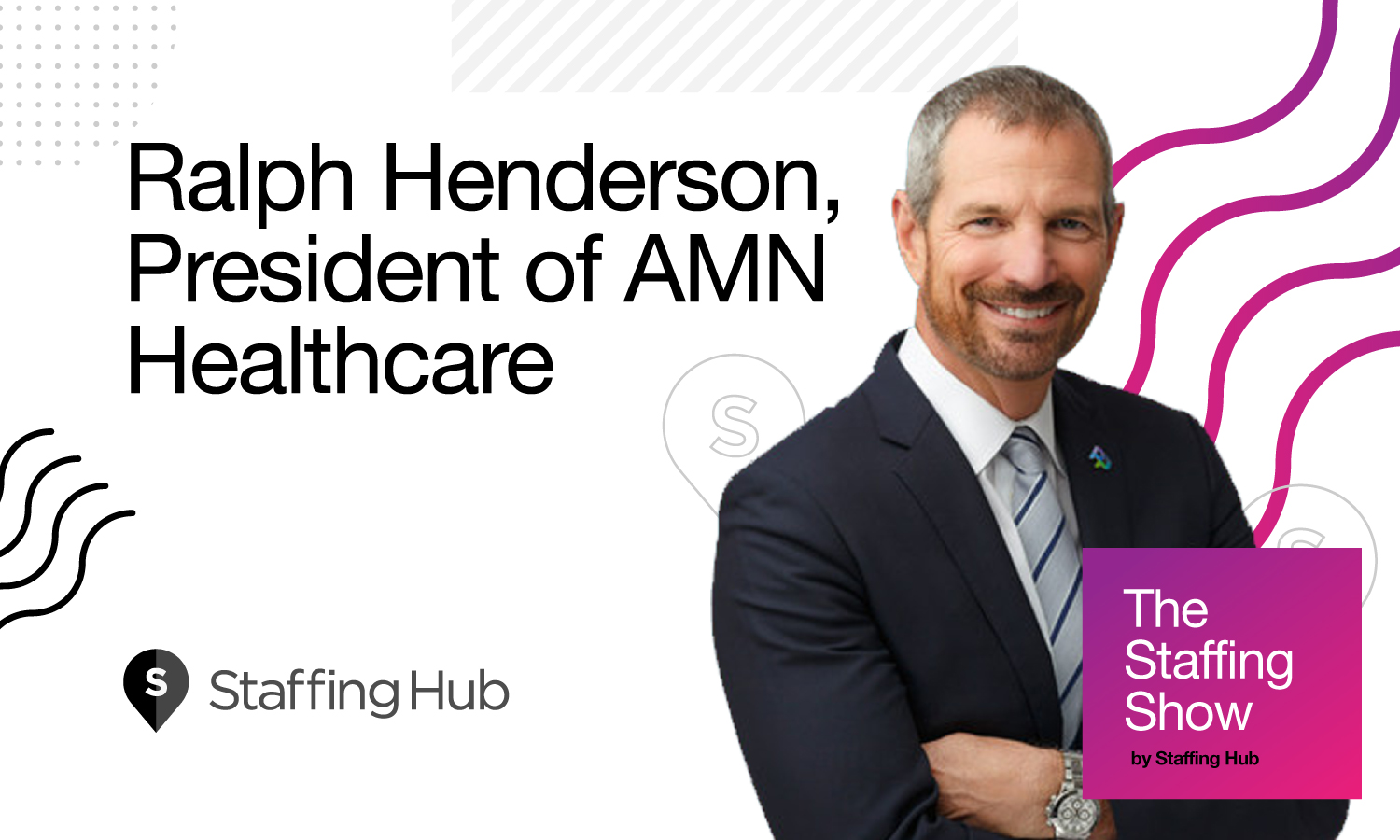
In this episode of The Staffing Show, Caitlin Delohery, the Editor in Chief of Staffing Hub, interviews Ralph Henderson, the President of Staffing and Professional Services for AMN Healthcare, about creating a people-driven culture as you scale, adopting the tech that helps recruiters thrive, and making Fortune’s 100 Fastest-Growing Companies list.
This interview took place at SIA’s 2018 Executive Forum — please excuse the background noise. It’s just the sound of the rest of the staffing industry making great connections!
Here’s the transcript of the episode.
Staffing Hub: What do you think has driven AMN’s success?
Ralph: Three main things that I would say drove our success. I’ll start at the high level: our culture, our strategy, and our execution.
Our strategy is really a customer-driven focus. We spend a lot of time trying to look forward to where the industry is going, asking our customers what workforce-related needs that might have, and then developing products and services that meet those needs. We focus not just on what’s happening to them today, but where they think they’re going in the future.
Our execution is a very process + technology model. We’re a Lean Six Sigma company, and we’re believers in finding the waste and doing things as efficiently as possible. That applies to customer experience with us and how that translates into the way we do business.
So, when customers click on your website, you want them to have a look and feel that’s familiar, right? So, we try to do that in business, which is a little unique. Our execution is driven a lot by our team members, who make up our culture.
It’s a really, really cool company.
The work we do has purpose — it feels good to find a doctor for that rural town that needs one and a nurse that can deliver babies.
I’ve worked for some good ones. I started my career at American Express, and I went from there to Spherion, which is a great company. I’ve really found AMN to be unique to the industry as well. It’s a unique company among all Fortune companies.
We have a lot of employees who stay a long time. People move around the organization — there are lots of different career opportunities for them. Our team is very customer-centered. The work we do has purpose — it feels good to find a doctor for that rural town that needs one and a nurse that can deliver babies.
Somehow, we’ve been able to preserve our culture, even with 3,000 employees, and at the size we are, I think that’s one of the things that makes us special.
The work itself has that element to it. Bundling that all up is I think how we interact with each other. It’s unique — it’s very collaborative. People get a voice. If you have a suggestion or an innovation, we look at it. You’re not a number. We may be a big company, but in many ways, AMN seems like a bunch of people sitting around in a conference room.
Somehow, we’ve been able to preserve our culture, even with 3,000 employees, and at the size we are, I think that’s one of the things that makes us special.
Staffing Hub: How do you think you’ve preserved that? Because that seems like a huge challenge at that level.
Henderson: I would give a lot of credit for that to Susan Salka, our CEO, and Julie Fletcher, who’s our Chief Talent Officer. They’re able to find those bright spots about our organization, and then expand on them.
Julie calls it that one unique thing. Every employee has one special circumstance that they need their employer to be flexible with. For me, it was being home in time to coach my son’s soccer team. For somebody else it might be, “I want to have a flexible start time in the morning.” For somebody else it might be, “I’m going to work remote one day a month.”
So Julie says, “We enable that.” Whatever your one thing is. So, she really fosters that, which makes everyone’s experience personal. It’s like there isn’t a formula, which is I think the downside of most big companies. I think that’s why she brought it.
Even when you’re having one of your bad days, and you have your customer you can’t satisfy, or some technology isn’t working just the way it’s supposed to, you can lean on that and say, “Okay, yeah, but I still got my one thing.”
Susan, on the other hand, she’s charismatic, she’s poised, people want to work harder after they spend time with her. She is enthusiastic about our team, our mission overall, and she gets in front of customers. She loves doing what she was just doing, wandering around an exhibit hall is the CEO of a fortune company.
That’s not what you’d expect your CEO to be like.
That’s exactly who she is at work, too. She is able to keep her, probably, entrepreneurial roots — just walking the floors and getting enthusiastic and excited about things. She still does that.
She dressed up once in a Catwoman suit when we hit a certain goal. She’ll lead us all out on the dance floor at one of our events. That’s not what you’d expect your CEO to be like.
I think that adds a lot. I give those two a lot of credit. But, I think the rest of the team members deserve a lot for helping us remember our roots — remember those things that make us unique, not letting our heads get too big. And really always staying focused on the clinicians and the customers.
I think that adds a lot. I give those two a lot of credit. But, I think the rest of the team members deserve a lot for helping us remember our roots — remember those things that make us unique, not letting our heads get too big. And really always staying focused on the clinicians and the customers.
It can be a difficult business at times — you can’t meet everyone’s needs, we don’t manufacture nurses in the backroom. It comes with frustrations, so if you don’t have those lighthearted moments, it’s a little more difficult.
Staffing Hub: So, it felt like you’ve given me a really good picture of the human aspect, which is the heart of AMN. You’ve mentioned technology a few times, how do those interact? How does technology allow you to continue to be so human?
Henderson: That’s a really good way to word it. Early technologies in the staffing industry were developed by somebody who went into a conference room and designed a piece of software that they thought would help people do their jobs. And in many cases, it made the job more difficult. You spent more of your time keying in data than you did interacting with candidates and customers.
Where recruiting adds value, and where account management adds value in the process to our healthcare customers is not in the administrative work, but it’s in the emotional part of the decision.
So, there’s been quite an evolution of products that are available out there that are extremely flexible and that personalize the candidate experience. You shouldn’t have to put your name in an application, and then put it in again on your I9 form, and put it in again over and over and over again.
We’ve used technology to take the administrative work away from our recruiters and our account managers to the extent possible, and for the candidate’s experience and the client experience. As few times as we can ask a question, so we show that we know you from transaction to transaction.
Where recruiting adds value, and where account management adds value in the process to our healthcare customers is not in the administrative work, but it’s in the emotional part of the decision. As a recruiter, they’re trying to convince you that this is the right next step for your career, this is the right fit for you from a cultural standpoint, at a hospital you would want to work at, that it’s not as hard as you think to travel across the country and try something different.
When you use technology to take away the other parts of their job and let recruiters do the part of their job where they add the most value, I think you create a better environment.
You’re going to learn new skills while you’re there. These are emotional things, I can’t automate them, and I don’t want to. The same thing with the account manager, is that the right candidate for me? Do they fit our environment? Do they have the skills they need to do the job? Will they be on time, will they show up, will they be a distraction to the unit?
When you use technology to take away the other parts of their job and let recruiters do the part of their job where they add the most value, I think you create a better environment.
They could do more, they could earn more because they focused on that central part of that transaction. And I hate to call it a transaction because it’s a career decision, but in some ways, it’s a transaction from a technology standpoint.
StaffingHub: And you’ve seen technology and the entire industry change over the past decade or so, and it seems to be speeding up a lot, especially in terms of tech, but I think also in terms of the understanding of that human interaction at the center of everything. If you’re going to put your fortune teller hat on, how do you anticipate the industry changing in the next two to five years?
That big change has really been amazing in the last five years — tech went from being a burden to the recruiter and the account manager to something that actually helps them do their job better.
Henderson: A couple things to think about — you’re right, I started almost 25 years ago in the industry, and we actually did have tech back then, I’m not that old.
It was a green screen, but we did have a database. It was there for financial transactions and to monitor work productivity, to facilitate the workflow and how things are supposed to happen or gather information along the way.
That big change has really been amazing in the last five years — tech went from being a burden to the recruiter and the account manager to something that actually helps them do their job better.
A lot of people use all these fancy words — artificial intelligence or stuff like that — but it’s really just understanding the history of what happened. You can deconstruct that and you can turn that into ways to change the industry.
In the last two or three years, you’re seeing the introduction of — because those systems work so well at enabling those transactions and those placements, the data that’s gathered from that is really rich: why people don’t take jobs, why they do, when do they click with the recruiters, when do they not, what’s the best time to call them. Things like that start to come out of the data. A lot of people use all these fancy words — artificial intelligence or stuff like that — but it’s really just understanding the history of what happened. You can deconstruct that and you can turn that into ways to change the industry.
One of the things we’ve done is we have an algorithm that tells the recruiters who’s the best person to call when they first arrive at the office in the morning. Based on what we saw last night, which is your activities as a candidate on our website, you were looking at jobs, you might have come to us from CareerBuilder or Monster — we know that. We know that you have this specialty and that you are looking at jobs in that specialty. We also know what city and state you were looking at, too.
We also know what orders we have, we matched it up overnight, that fit what you were doing that you may not have found. We could actually then add information about you just based on your profile, so who you are, where you went to school, our interactions with you in the past.
And you take all of that information and you tell a recruiter, “this person’s probably ready to look for a job.” We use the term “job embeddedness.” How ready are you to go look for your next opportunity?
You see these surveys constantly: “30% of people could lose their job at any moment.” That’s because we’re all constantly looking for this or something better.
But, if I could tell you when they’re really ready, the closer they are to that “something better” — that’s what we’re able to do.
So we tell our recruiters, “This is a person has spent enough time searching,” and so we curate that for them, so that when they make the call, they’re talking to somebody who’s highly interested. So, instead of culling through big databases, calling people who don’t really want to hear from you, who just wanted to look at jobs, and may have a passive interest at this point. So, we can move them along, we can watch what they’ve done, we can take more information — this wasn’t even available three years ago.
On that same hand, we use technology to help identify, next, what are the best job opportunities for our recruiters to work on. That’s the client who interviews that fastest. The client that has the least friction in their onboarding and hiring process. They’re really looking to make a move.
We put those two things together and you end up with a very powerful combination which has led to our growth.
Staffing Hub: How do you think that will change the way recruiting teams work? You’ve seen firsthand probably how it’s changed, so how do you think it will change industry-wide?
[R]ecruiting organizations will probably look smaller in the future, from a headcount standpoint. Recruiters may be more productive and be able to manage more requisitions, more candidates, than they have in the past.
Henderson: I think that when you look at the industry — I do think of the people who interact with the clients as the heart and soul of the business. We used to have to surround them with five or six other people. So, some of those roles may not exist. I know that’s everybody’s big fear.
And back to that emotional part, I don’t believe that that will go away, but I do think that there will be some task -oriented things and administrative things that are not necessary parts of the equation, and not really value-adds.
That change will be mean that recruiting organizations will probably look smaller in the future, from a headcount standpoint. Recruiters may be more productive and be able to manage more requisitions, more candidates, than they have in the past. We are seeing that.
There are times when the clients look at staffing as a necessary evil or something that is a sign that their internal recruitment department failed. I don’t want them to see us like that. I want them to see us as somebody who’s curating talent for them in ways they can’t do it themselves.
Clients will have more data to make decisions as well, so I think they’ll make better decisions and faster decisions. The data will get presented to them in such a way that they can do that. Today, it comes in randomly: there’s a CV, here’s an app, here’s the skills checklist, here’s their background check, here’s their drug screening.
It would be nice to have a more holistic picture, and I think whenever that happens, when our industry pulls that together, I think our clients will be more satisfied.
There are times when the clients look at staffing as a necessary evil or something that is a sign that their internal recruitment department failed. I don’t want them to see us like that. I want them to see us as somebody who’s curating talent for them in ways they can’t do it themselves.
The other thing that’s changing a lot is — early in my career, you were only a temp because you couldn’t get a full-time job. The industry was industrial and clerical, primarily. That world has changed. Now, having the freedom to where I want to work, and the days I want to work, and the shifts I want to work — that empowers people.
People are feeling like that should be populated in greater amounts. Sometimes, you get jealous of people that have that kind of job flexibility — they get to work from home, and they set their own hours. That’s coming at us fast and furious.
How does that fit into some of the environments that we staff and how do we take our clients and move them? Because if you’re dead-set on the 40 hour work week, 8 to 5, you’re going to be less attractive to a workforce that wants to work… you know, 8-5 some days, but I want to work from home on Fridays, and I probably want to work straight through lunch and go home at 4 on Wednesday, and I want to come in late so I can take my daughter to swim practice on Tuesday.
I think that change will force all of us toward more sophisticated tools for identifying ways to schedule candidates. That means optimizing the workforce — not just based on the client’s needs, which is the way it’s always been done, or the employer’s needs. “We need people to work these hours, so that’s what everybody works.”
Instead, you’ll be able to plug and play a little bit differently. And maybe two people can share a job easier, or you could fill a single job with five different doctors. It’s an emergency room and they all have the same skills — let’s use five doctors to fill that. So, then there are five part-time doctors that get what they wanted, rather than maybe dropping out of the workforce. They stay active.
So, I think there will be in the technological advances to help us get there.
We have acquired one company that does workforce optimization. Their focus is primarily on nurse staffing and acute care hospitals. It’s called Avantas — they have a technology that helps hospitals predict their needs. It looks at patient data, census data, seasonal patterns in the weather, whether or not the local football game is a home game or not because emergency room visits go up whenever there’s a home game.
So, it takes that model and combines all of that, and says, “Okay, here’s how you should staff, here’s how much your workforce should be core, how much should be flexible workforce. Here are a few shifts that may be really tough to fill. You should give those to your supplier network sooner rather than later, so you get the best talent out of that network.”
And, it’s not at the very last second — you know well in advance. And it’s highly accurate — in the high 90 percentile, even for as much as 30, 60, 90 days out. Most of my clients are almost week-to-week on filling their schedule. It’s a relief to a customer to be able to do that.
I think those technologies, we’ve acquired, they’re a way into that. We need to integrate that better with everything we do. Those are some unique opportunities for the staffing industry. Add more value than just filling that one shift. We’re going to tell you it needs to be filled, and fill it. We might be able to help you with your turnover. Maybe your people don’t want to work four to five days a week anymore. We could come up with a model that might help you in other ways to try your best.
Staffing Hub: With that model in place, this all seems very next level. What are your day-to-day challenges?
All the technology isn’t going to create nurses and doctors.
Henderson: All the technology isn’t going to create nurses and doctors.
Candidate acquisition is the number one challenge of my job. It’s still what excites me. Usually when things are going wrong, it frustrates you, but for me, it doesn’t. For me, it’s just a different type of challenge.
On any given day there are 300,000 RNs who aren’t working anywhere, because they don’t want to. I think a lot about: how do I come up with options for them? How do I get those 300,000 back to work?
So, I spend a lot of my time, more than half of my time, thinking about the candidate. What do they want, how do we get more of them to come to our assignments? What are they looking for? Comp, benefits, work locations, recruitment process, screening process — in order to make them want to work a little bit more for me and maybe not do something else, or even stay home.
3 million nurses, and on any given day there are 300,000 RNs who aren’t working anywhere, because they don’t want to. I think a lot about: how do I come up with options for them? How do I get those 300,000 back to work?
The same with doctors. The model there is evolving, the gender balance is definitely flip-flopping. It used to be this male-dominated industry, you owned your own practice, and if another doctor was out, you filled in for him.
Now, people want work-life balance — male and female. They may only want to work two or three days a week, and they want different work arrangements than existed. I try to think about how we can create environments for those people to have a work experience.
So, the other part is, there’s a geographic distribution issue. Sometimes, there are more RNs in Alabama that they need in Alabama. My job is to get them into California and get the second license or a third license and to try to help resolve that logistics issue. And it exists not just in nurses, but in all specialties. There are PTs concentrated sometimes in big cities, and I need them to work in rural communities.
So, trying to move people and find out what motivates people to get them to do that.
StaffingHub: Is that about building in processes to, say, help nurses find their way out of burn out? Or incentivize moving locations? Or is it a different level of thinking in terms of meeting these challenges?
Henderson: You captured a couple of them — sometimes just being part of an organization for a long period of time, people do get burned out, or they feel the politics, and they don’t get to do the core work that they went to school to do.
“I just want to be a nurse. I just want to serve patients.” They’re pulled into training, and they’re part of compliance, and all types of different work that’s not as attractive to them — that’s not why they went to school.
Helping them find new career opportunities. And helping the clients understand whenever they’re creating an environment that causes that. That’s just part of my job. I think oftentimes those things build up over time, and people can’t see it. I’m sure I have some in my own organization I ought to be looking at. That is part of the job — facilitating them into where you want to be in your career.\
When I look out as to where AMN will go, certainly, it’s been a really, really fun few years for us. I think one of my proudest accomplishments was being on the Fortune’s Fastest- Growing Companies List.
When I look out as to where AMN will go, certainly, it’s been a really, really fun few years for us. I think one of my proudest accomplishments was being on the Fortune’s Fastest- Growing Companies List. My whole career, I’ve been in a lot of high-growth companies, but never really had a three-year run where you made it on the list. We ended up number 11, we’re just a couple slots behind Amazon, which I thought was pretty fun.
I watch the evolution of medicine. I do like to think about, what will be next, what will be the services that they’re going to want us to provide?
I think there’s more ahead for us. Every day I talk to somebody who’s hospital has to close beds or can’t do surgeries or can’t treat patients overnight in a way they want to do it. I watch the evolution of medicine. I do like to think about, what will be next, what will be the services that they’re going to want us to provide?
One of my better examples is ambulance drivers. If the cars are driverless, the ambulances definitely will be driverless first, right? And if there are two people in that car, I want them both back there working on me or my patients.
That shifts things. How do other changes in the market start to impact us? Is it possible that healthcare is not going to be delivered as much in an acute care hospital, but it’ll be delivered in my house. Will my doctor be remote at some point? Will my surgeon be remote? What does that mean for the workforce?
Maybe robots in healthcare, who knows?
I have a presentation I do about the future of healthcare, and then, I do a second session on the future of the worker, what workers want. They’re actually going to match up pretty well. I have a lot of confidence in that. I don’t go to dark places when I do it, but things like constant monitoring on your health, devices on your body that tell you how healthy you are. Medicine that is specific to you — not just specific to your height, and your weight, and your sex.
Okay, you get 800 milligrams of that, and now it customizes down to the individual level. That means a pharmacist who mixes up compounds specific to me and my DNA. That job doesn’t exist today. How do I fill that job in the future? What do we need to do to be in the right position to do that?
I can imagine us being a big part of that. Maybe robots in healthcare, who knows?
I think there are some interesting places for it. There are some places where moving patients around the facility — people can get hurt doing that. It’s stressful work. Patients get hurt. There’s gotta be better ways to do it. You could see that. When you go to automated facilities, they can do some pretty tricky things like that. I’m like, “Okay, how will that impact healthcare?” I think those are things that will make a nurse’s life better.
Staffing Hub: That’s interesting, because it seems to me those kind of things are exactly what you’ll need to keep heart-centered, or what you need the personal touch for, right at the center of healthcare, and the rest will be more automated.
Henderson: The nice thing about healthcare is it’s a hands-on industry. We’re not going to outsource it. That’s why I said, “I don’t go to dark places.” Less paperwork, the nurses are doing less paperwork, the doctors are in front of the patients more. They have all the data they need to make decisions. That creates a more efficient system. And AMN wants to be part of that.
Want more podcasts? Check out our all our episodes.


